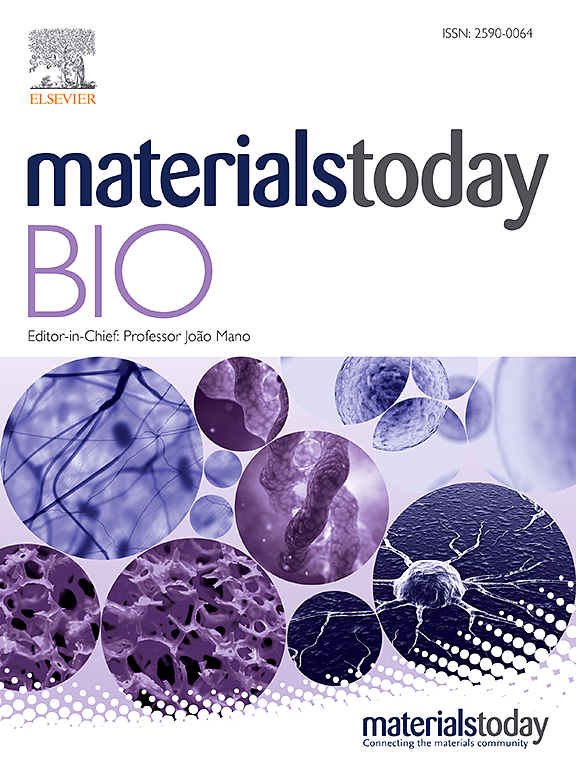The dimethyloxalylglycine-functionalized nanofibers for in situ regeneration of infected developing dental roots
IF 10.2
1区 医学
Q1 ENGINEERING, BIOMEDICAL
引用次数: 0
Abstract
In situ regeneration in restorative dentistry targets the repair of tissues directly at the injury site by utilizing engineered biomaterials to guide endogenous cell activity. This approach aims to simplify treatment procedures and achieve more predictable outcomes, thus to supports the regeneration of damaged tissues and potentially restores tooth vitality, reducing the need for more invasive treatments. This study explores the potential of poly(ε-caprolactone) fibers (PCLF) functionalized with a hypoxia-inducible factor 1-alpha (HIF-1α) stabilizing small molecule dimethyloxalylglycine (DMOG) for in situ regeneration in the context of dental root repair in developing immature teeth. PCLF functionalized with DMOG (PCLF/DMOG) was applied to regenerative endodontic procedure (REP) treatment of infected developing dental roots, and its biologic properties and therapeutic potential were investigated through both in vitro studies and in vivo experiments, focusing on their capacity to promote in situ regeneration. In vivo application demonstrated the effectiveness of PCLF/DMOG in promoting root development, apical closure, and improving infectious lesions, contrasting with contemporary REP treatment controls that showed unpredictable outcomes. Mechanistically, the sustained release of DMOG from PCLF/DMOG significantly enhanced the expression of HIF-1α and upregulated expression of genes associated with angiogenesis and neurogenesis, including VEGF-α and NGF. The PCLF/DMOG upregulated antimicrobial peptides, facilitated efferocytic activities, promoted macrophage polarization to the M2 phenotype, and mobilized mesenchymal stem cells. Taken together, PCLF/DMOG could enhance innate immune responses and foster favorable microenvironment to guide cellular differentiation, promoting in situ regeneration of dental roots in the inflammatory microenvironments.

二甲基氧基甘氨酸功能化纳米纤维在受感染牙根原位再生中的应用
修复性牙科的原位再生是利用工程生物材料来引导内源性细胞活性,直接修复损伤部位的组织。该方法旨在简化治疗程序,获得更可预测的结果,从而支持受损组织的再生,并有可能恢复牙齿活力,减少更多侵入性治疗的需要。本研究探讨了低氧诱导因子1- α (HIF-1α)功能化聚(ε-己内酯)纤维(PCLF)稳定小分子二甲基氧基酰甘氨酸(DMOG)在发育中的未成熟牙齿牙根修复中的原位再生潜力。将DMOG功能化的PCLF (PCLF/DMOG)应用于再生根管治疗(REP),并通过体外和体内实验研究其生物学特性和治疗潜力,重点研究其促进原位再生的能力。体内应用表明PCLF/DMOG在促进根发育、根尖闭合和改善感染性病变方面的有效性,而当代REP治疗对照显示出不可预测的结果。从机制上讲,PCLF/DMOG持续释放DMOG可显著增强HIF-1α的表达,并上调血管生成和神经发生相关基因(包括VEGF-α和NGF)的表达。PCLF/DMOG上调抗菌肽水平,促进细胞活性,促进巨噬细胞向M2型极化,调动间充质干细胞。综上所述,PCLF/DMOG可以增强先天免疫反应,营造良好的微环境来引导细胞分化,促进牙根在炎症微环境中的原位再生。
本文章由计算机程序翻译,如有差异,请以英文原文为准。
求助全文
约1分钟内获得全文
求助全文
来源期刊

Materials Today Bio
Multiple-
CiteScore
8.30
自引率
4.90%
发文量
303
审稿时长
30 days
期刊介绍:
Materials Today Bio is a multidisciplinary journal that specializes in the intersection between biology and materials science, chemistry, physics, engineering, and medicine. It covers various aspects such as the design and assembly of new structures, their interaction with biological systems, functionalization, bioimaging, therapies, and diagnostics in healthcare. The journal aims to showcase the most significant advancements and discoveries in this field. As part of the Materials Today family, Materials Today Bio provides rigorous peer review, quick decision-making, and high visibility for authors. It is indexed in Scopus, PubMed Central, Emerging Sources, Citation Index (ESCI), and Directory of Open Access Journals (DOAJ).
 求助内容:
求助内容: 应助结果提醒方式:
应助结果提醒方式:


